Raphael Sanzio
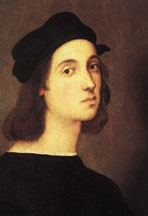
1483-1521
|
Raphael was a painter of the
Italian "High Renaissance", considered one of the greatest and
most popular artists of all time. Unlike Leonardo and Michelangelo, Raphael
was to live a very short life, dying at the youthful age of 38. He was
born Raffaello Santi or Raffaello Sanzio in Urbino on April 6, 1483, and
received his early training in art from his father, Giovanni Santi. In
1499 he went to Perugia, in Umbria, and became a student and assistant
of the painter Perugino. Raphael imitated his master closely, and their
painting styles are so similar that art historians have found it difficult
to determine which were painted by Raphael, and which were by his master.
This was the beginning of his career as an absorber of influences. It
is said of Raphael that whatever he saw, he took possession of, always
growing by what was taught to him.

St. George and the Dragon,
1505
|
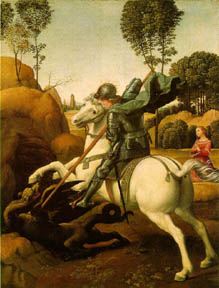
St. George and The Dragon,
1504-6
|
Both of these images of St.
George Fighting the Dragon were painted when the artist was in his
early twenties. They echo the gentle expression of his teacher, Perugino
(especially in the little praying princess). There is, however, a sense
of vigor in the knight and his horse and the dragon that was beyond Perugino's
skill.
Raphael is best known for his many images of Madonnas (some
of his most popular ones have been made into postage stamps, above). An
interesting irony for these scenes of quiet faith is the notion, recorded
by the historian Giorgio Vasari (a contemporary of Raphael's time), that
Raphael was an atheist,
and that he painted what would be acceptable, not what he felt to be true.
He was, however, an appreciator of feminine beauty, and was noted to have
been a "ladies man". It is possible that many of the images of
Mary were posed by the same woman.
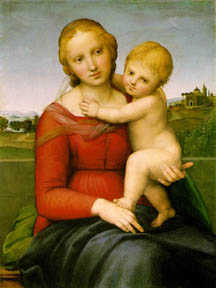
Cowper Madonna, 1504
|
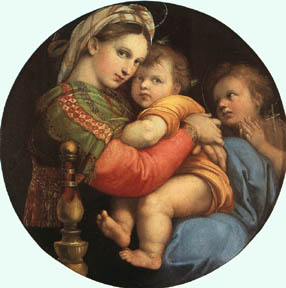
Madonna of the Chair,
1518
|
It is believed that
his Madonnas were particularly influenced by Leonardo, with whom he came under
direct influence when Raphael moved to Florence. The small Cowper Madonna,
with its softness of contour and perfection of balance, has been noted for
its resemblance to some of Leonardo's paintings of the subject. Madonna
of the Chair was created more than a decade later, but also reflects the
sweetness and harmony that we have come to identify with Raphael. It is considered
by many to be the most popular of all Raphael madonnas, and was probably painted
for Pope Leo X, or one of the Medici. Of particular interest is the circular
design. All of the interlocking arms and legs, and the directional gazes within
the picture serve to emphasize the circular composition.
In 1508 Raphael
was called to Rome by Pope Julius II and commissioned to execute frescoes
in four small rooms of the Vatican Palace. The walls of the first room are
decorated with scenes elaborating ideas suggested by personifications of Theology,
Philosophy, Poetry, and Justice, which appear on the upper walls. The most
famous of these compositions is The School of Athens, which represents
the concept of Philosophy. The painting displays the greatest thinkers
of the Greek world, most notably Plato and Aristotle, who are at the center
of the composition. As with Leonardo's Last Supper, all of the architectural
lines lead back to a vanishing point right behind the main center of interest,
and the arch doorway serves to emphasize their importance. Though the artist
portrays famous thinkers from a thousand years before his time, he uses portraits
of his contemporaries to serve the composition. In the place of Plato, for
instance, it is likely that the portrait is that of Leonardo. Likewise, Michelangelo
is in the foreground (depicted as Heraclitus), leaning against a block. During
the time of Leonardo's painting, Michelangelo was also creating the Sistine
Chapel frescos (also within the Vatican). A well-known story suggests that
Raphael snuck into the Sistine Chapel, while the painting of its ceiling was
in progress. Michaelangelo was added after Raphael found himself influenced
by the energy and action of Michaelangelo's compositions.
Raphael portrays
himself in a less significant area of the School of Athens. He peers out at
the viewer from the center of a group of scholars that are crowded together
at the far right edge of the composition. Probably many of the other persons
within the painting are posed by contemporaries. I have noticed the similarity
between one figure and a famous portait of a young man named Bindo Altoviti
(below).
Portraits
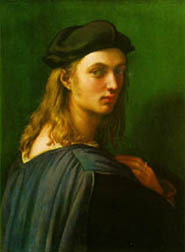
Portrait of Bindo
Altoviti
1515
|
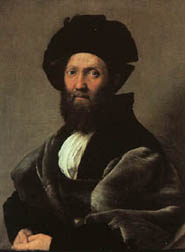
Baldassare
Castiglione
1514-15
|
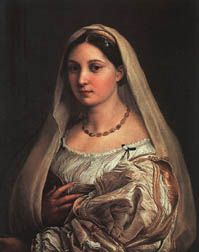
La Donna Velata
1515
|
|
For many years, historians believed
that youth at left was Raphael himself. He was said to be unusually handsome,
pensive, and fair, but it is now agreed that it is Bindo Altoviti at 22
(Raphael was 33, with only five years left to live). I personally find Raphael's
portraits to be some of his most compelling works. The portrait of Baldassari
Castiglione is a particularly sensitive rendition of a well-known Renaissance
humanist writer. La Donna Velata is possibly the same woman who is portrayed
in many of his Madonna images, and is believed to have been the painter's
mistress. All three portraits are exquisite examples of Renaissance temperance
and style.
Last
Works
(click below images for
larger versions)
Raphael's final paintings are some of his most powerful religious works.
The Sistine Madonna is his last image of the heavenly mother. It is much
more supernatural than his previous works, as Mary treads on pillowy clouds
and is surrounded by musing angels. The return of such supernatural images
will influence the works of the Mannerist painters, who emulate the dramatic
style of Raphael's later works.
| The Transfiguration
of Christ is the final work of Raphael's life, and is believed to
have been unfinished (probably completed by one of his students). Raphael
did not paint the standard interpretation of the story, as he combines
it with the story of The Healing of the Lunatic Boy. After ascending
the "mountain of revelation," Christ was transfigured before the three
awestruck apostles. A dramatic white light emanated from behind Christ.
Although it is written in the Gospels that the events of The Healing
of the Lunatic Boy actually followed The Transfiguration, Raphael joined
them at one point in time. In the Gospels the possessed boy was brought
to the apostles to be freed of his demonic possession. However the twelve
apostles, "small and impotent," were unable to cure the sick child until
Christ arrived. The Transfigured Christ, to whom one of the apostles
points, is the only help, and the unlifted arms pointing to the vision
form the connecting link between the two regions. Their directioning
joins the two scenes by announcing that Christ is the savior of man;
only he can heal the pains of this life. |
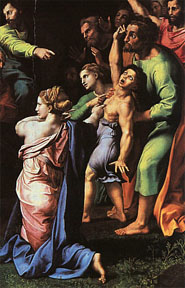
(detail of lunatic boy in Transfiguration) |
Raphael's art has fallen
out of favor in contemporary times because it seems almost too perfect and
sweet. Many art historians believe that it lacks the dynamic power of Leonardo
or Michelangelo's works. However, Raphael was a great artist, who exemplified
the tastes of his time. During his lifetime, he was perhaps as famous as the
great Michelangelo, and received so many commissions that he had a difficult
time keeping up with them. He had a tremendous impact on artists that were
to follow him, which is especially significant given his short life. At the
age of 38, he contracted a fever, which was probably caused by an insect bite.
He would probably have healed, but for the continued practice of medieval
medicine, which prompted the doctors to bleed him with leeches, attempting
to get the "bad blood" out. One can only wonder what he would have
achieved if given the long life spans of Leonardo or Michelangelo. Though
much younger than Michelangelo, he died 43 years before him. The death of
Michelangelo will mark the end of the High Renaissance. A transitional period,
called "Mannerism" will take place for the next 50 years, before
the beginning of the Baroque era.
to Mannerism
|